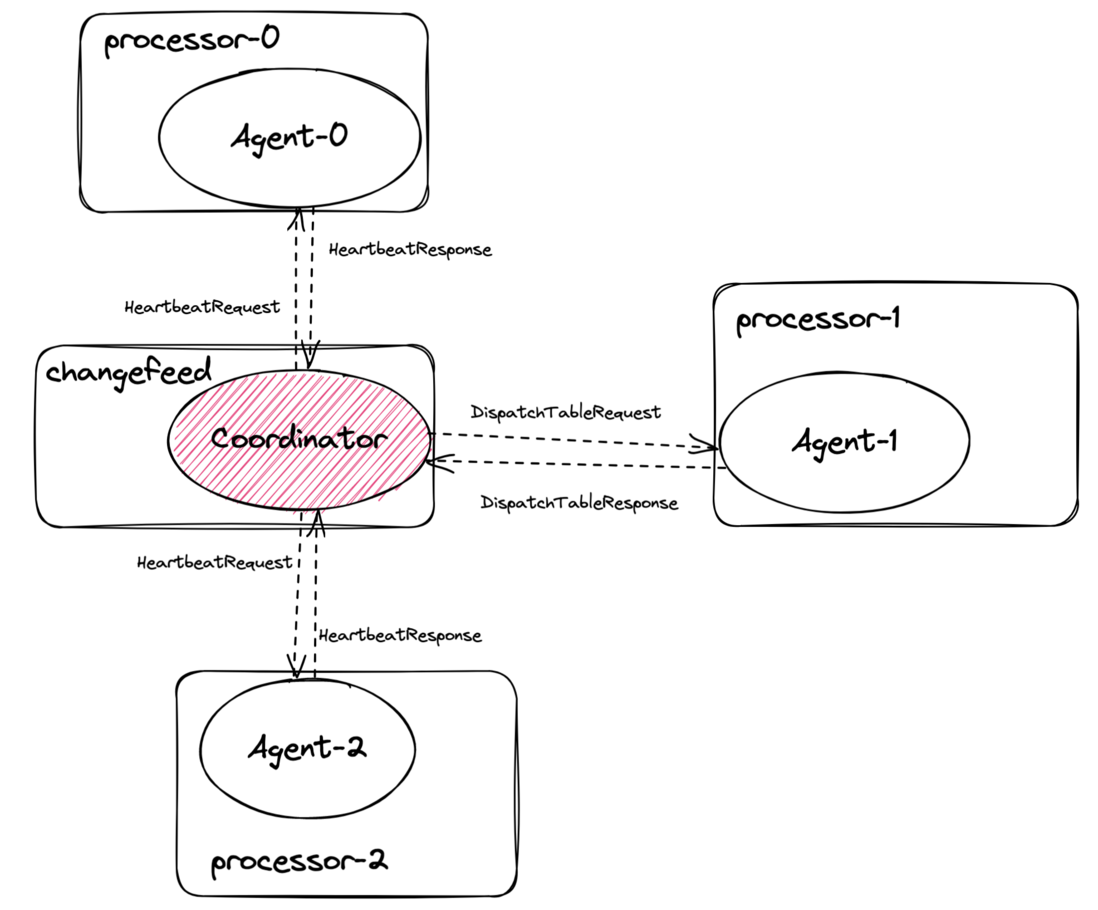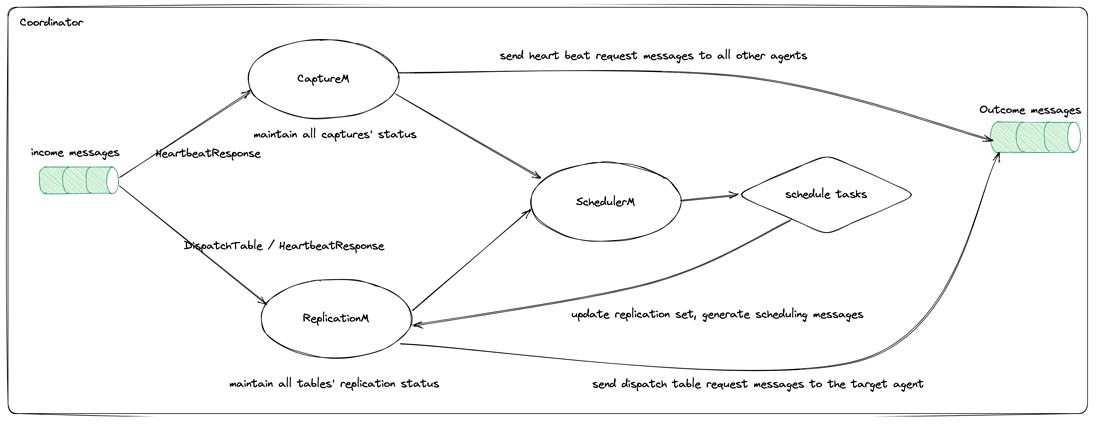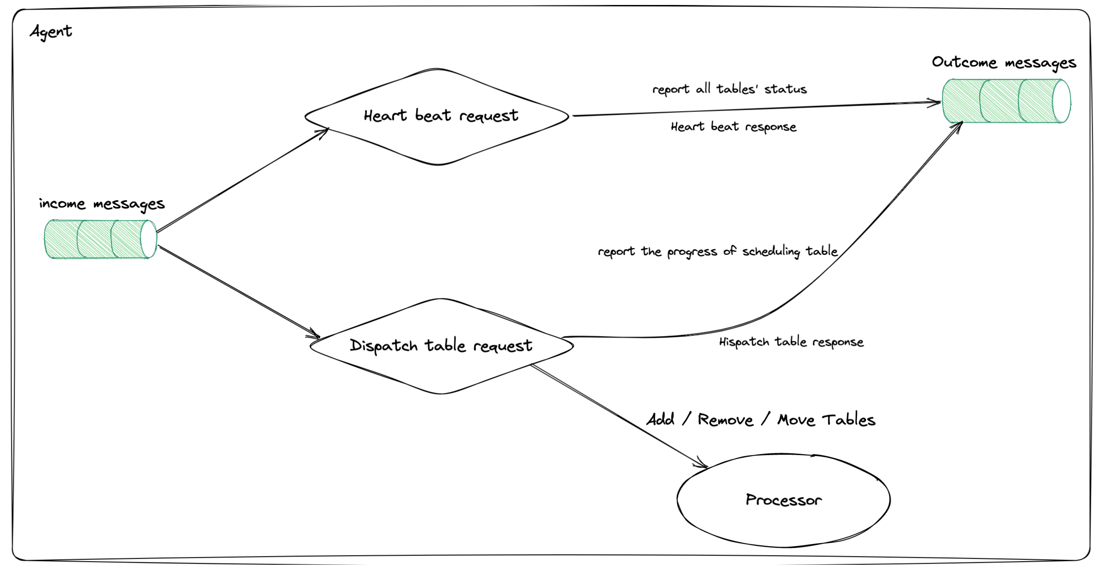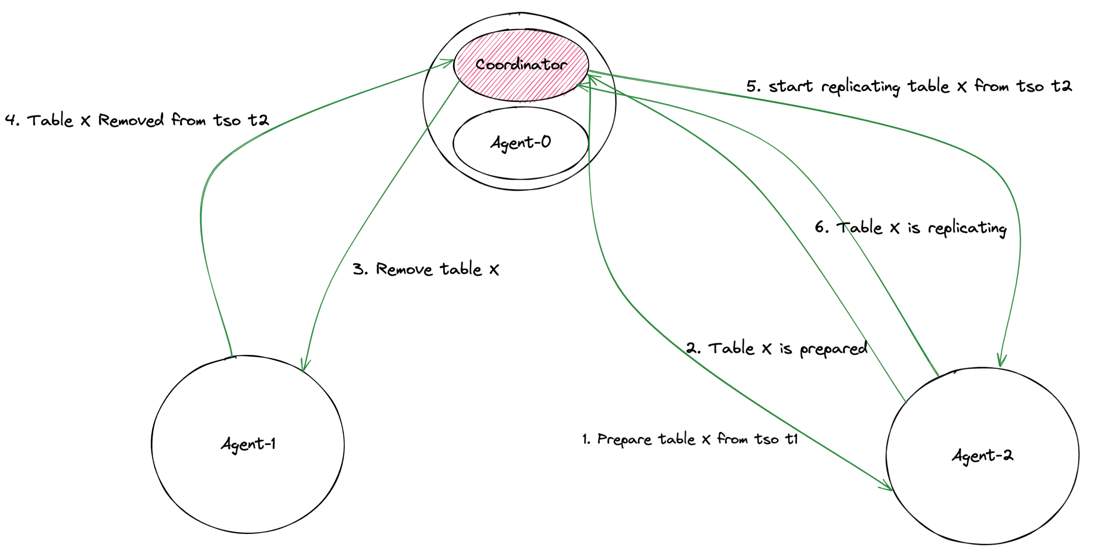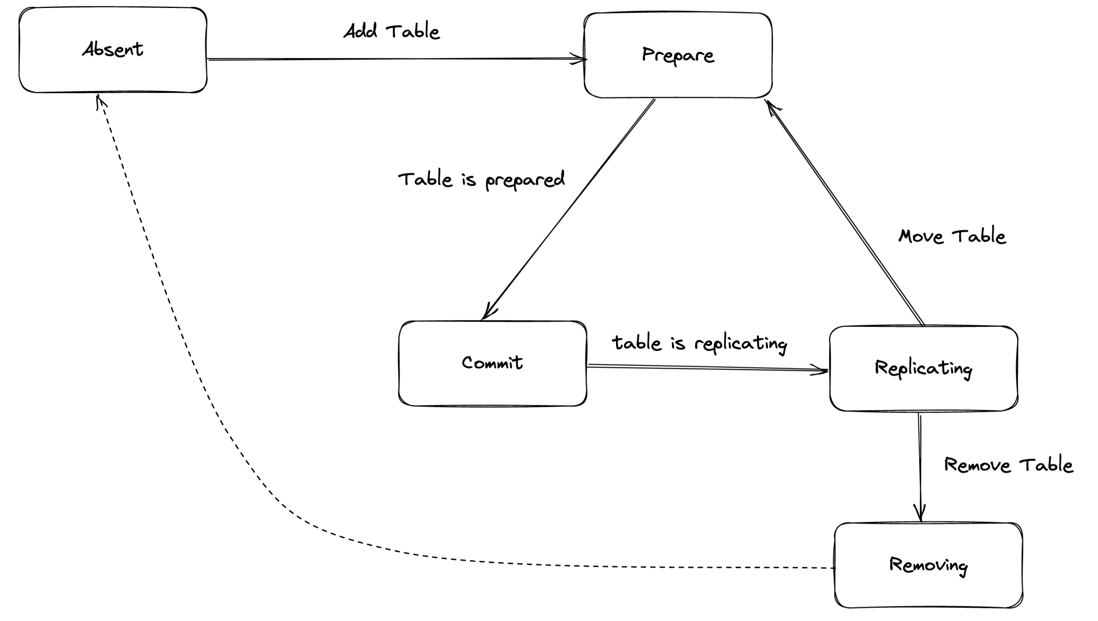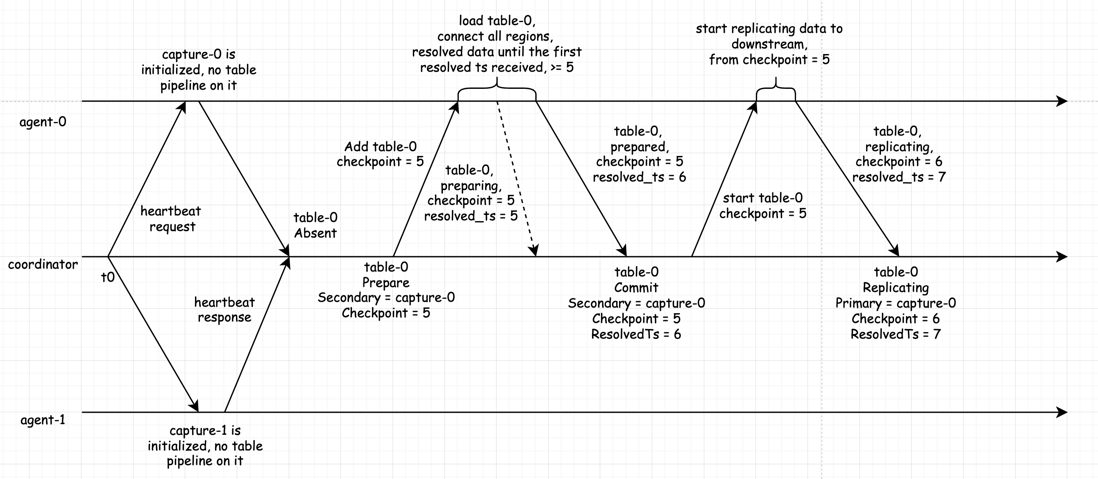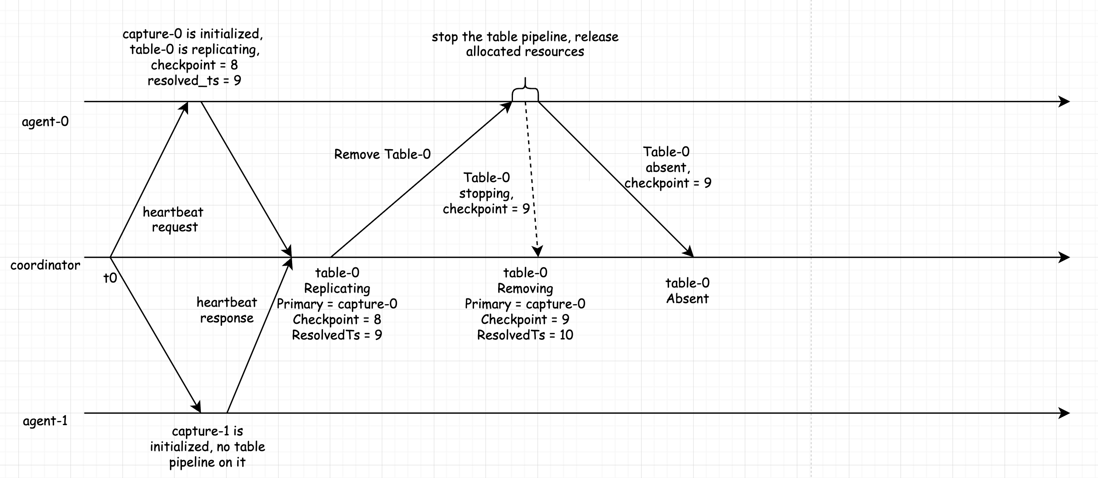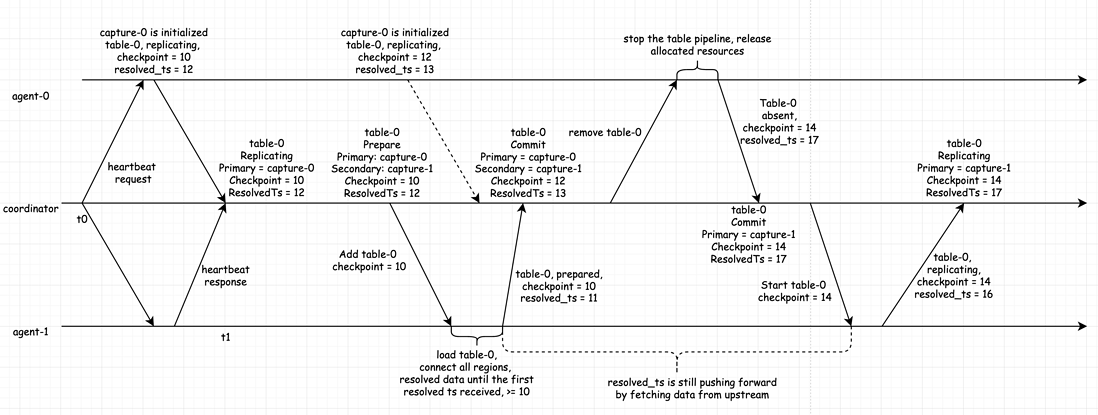本文是 TiCDC 原始碼解讀的第四篇,主要內容是講述 TiCDC 中 Scheduler 模組的工作原理。主要內容如下:
- Scheduler 模組的工作機制
- 兩階段排程原理
Scheduler 模組介紹
Scheduler 是 Changefeed 內的一個重要模組,它主要負責兩件事情:
- 將一個 Changefeed 所有需要被同步的表,分發到不同的 TiCDC 節點上進行同步工作,以達到負載均衡的目的。
- 維護每張表的同步進度,同時推進 Changefeed 的全域性同步進度。
本次介紹的 Scheduler 相關程式碼都在 tiflow/cdc/scheduler/internal/v3 目錄下,包含多個資料夾,具體如下:
- Coordinator 執行在 Changefeed,是 Scheduler 的全域性排程中心,負責傳送表排程任務,維護全部同步狀態。
- Agent 執行在 Processor,它接收表排程任務,彙報當前節點上的表同步狀態給 Coordinator。
- Transport 是對底層 peer-2-peer 機制的封裝,主要負責在 Coordinator 和 Agent 之間傳遞網路訊息。
- Member 主要是對叢集中 Captures 狀態的管理和維護。
- Replication 負責管理每張表的同步狀態。
ReplicationSet記錄了每張表的同步資訊,ReplicationManager負責管理所有的ReplicationSet。 - Scheduler 實現了多種不同的排程規則,可以由 OpenAPI 觸發。
下面我們詳細介紹 Scheduler 模組的工作過程。
表 & 表排程任務 & 表同步單元
TiCDC 的任務是以表為單位,將資料同步到下游目標節點。所以對於一張表,可以透過如下形式來表示,該資料結構即刻畫了一張表當前的同步進度。
type Table struct {
TableID model.TableID
Checkpoint uint64
ResolvedTs uint64
}Scheduler 主要是透過 Add Table / Remove Table / Move Table 三類表排程任務來平衡每個 TiCDC 節點上的正在同步的表數量。對於這三類任務,可以被簡單地刻畫為:
- Add Table:「TableID, Checkpoint, CaptureID」,即在 CaptureID 所指代的 Capture 上從 Checkpoint 開始載入並且同步 TableID 所指代的表同步單元。
- Remove Table:「TableID, CaptureID」,即從 CaptureID 所指代的 Capture 上移除 TableID 所指代的表同步單元。
- Move Table:「TableID, Source CaptureID, Target CaptureID」,即將 TableID 所指代的表同步單元從 Source CaptureID 指代的 Capture 上挪動到 Target CaptureID 指代的 Capture 之上。
表同步單元主要負責對一張表進行資料同步工作,在 TiCDC 內這由 Table Pipeline 實現。它的基本結構如下所示:
每個 Processor 開始同步一張表,即會為這張表建立一個 Table Pipeline,該過程可以分成兩個部分:
- 載入表:建立 Table Pipeline,分配相關的系統資源。KV-Client 從上游 TiKV 拉取資料,經由 Puller 寫入到 Sorter 中,但是此時不向下游目標資料系統寫入資料。
- 複製表:在載入表的前提下,啟動 Mounter 和 Sink 開始工作,從 Sorter 中讀取資料,並且寫入到下游目標資料系統。
Processor 實現了 TableExecutor 介面,如下所示:
type TableExecutor interface {
// AddTable add a new table with `startTs`
// if `isPrepare` is true, the 1st phase of the 2 phase scheduling protocol.
// if `isPrepare` is false, the 2nd phase.
AddTable(
ctx context.Context, tableID model.TableID, startTs model.Ts, isPrepare bool,
) (done bool, err error)
// IsAddTableFinished make sure the requested table is in the proper status
IsAddTableFinished(tableID model.TableID, isPrepare bool) (done bool)
// RemoveTable remove the table, return true if the table is already removed
RemoveTable(tableID model.TableID) (done bool)
// IsRemoveTableFinished convince the table is fully stopped.
// return false if table is not stopped
// return true and corresponding checkpoint otherwise.
IsRemoveTableFinished(tableID model.TableID) (model.Ts, bool)
// GetAllCurrentTables should return all tables that are being run,
// being added and being removed.
//
// NOTE: two subsequent calls to the method should return the same
// result, unless there is a call to AddTable, RemoveTable, IsAddTableFinished
// or IsRemoveTableFinished in between two calls to this method.
GetAllCurrentTables() []model.TableID
// GetCheckpoint returns the local checkpoint-ts and resolved-ts of
// the processor. Its calculation should take into consideration all
// tables that would have been returned if GetAllCurrentTables had been
// called immediately before.
GetCheckpoint() (checkpointTs, resolvedTs model.Ts)
// GetTableStatus return the checkpoint and resolved ts for the given table
GetTableStatus(tableID model.TableID) tablepb.TableStatus
}在 Changefeed 的整個執行週期中,Scheduler 都處於工作狀態,Agent 利用 Processor 提供的上述介面方法實現,實際地執行表排程任務,獲取到表排程任務進行的程度,以及表同步單元當前的執行狀態等,以供後續做出排程決策。
Coordinator & Agent
Scheduler 模組由 Coordinator 和 Agent 兩部分組成。Coordinator 執行在 Changefeed 內,Agent 執行在 Processor 內,Coordinator 和 Agent 即是 Changefeed 和 Processor 之間的通訊介面。二者使用 peer-2-peer 框架完成網路資料交換,該框架基於 gRPC 實現。下圖展示了一個有 3 個 TiCDC 節點的叢集中,一個 Changefeed 的 Scheduler 模組的通訊拓撲情況。可以看到,Coordinator 和 Agent 之間會交換兩類網路訊息,訊息格式由 Protobuf 定義,原始碼位於 tiflow/cdc/scheduler/schedulepb。
- 第一類是
Heartbeat訊息,Coordinator 週期性地向 Agent 傳送HeartbeatRequest,Agent 返回相應的HeartbeatResponse,該類訊息主要目的是讓 Coordinator 能夠及時獲取到所有表在不同 TiCDC 節點上的同步狀態。 - 第二類是
DispatchTable訊息,在有對錶進行排程的需求的時候,Coordinator 向特定 Agent 傳送DispatchTableRequest,後者返回DispatchTableResponse,用於及時同步每一張表的排程進展。
下面我們從訊息傳遞的角度,分別看一下 Coordinator 和 Agent 的工作邏輯。
Coordinator 工作過程
Coordinator 會收到來自 Agent 的 HeartbeatReponse 和 DispatchTableResponse 這兩類訊息。Coordinator 內的 CaptureM 負責維護 Capture 的狀態,在每次接收到 HeartbeatResponse 之後,都會更新自身維護的 Captures 的狀態,包括每個 Capture 當前的存活狀態,Capture 上當前同步的所有表資訊。同時也生成新的 HeartbeatRequest 訊息,再次傳送到所有 Agents。ReplicationM 負責維護所有表的同步狀態,它接收到 HeartbeatResponse 和 DispatchTableResponse 之後,按照訊息中記錄的表資訊,更新自己維護的這些表對應的同步狀態。CaptureM 提供了當前叢集中存活的所有 Captures 資訊,ReplicationM 則提供了所有表的同步狀態資訊,SchedulerM 以二者提供的資訊為輸入,以讓每個 Capture 上的表同步單元數量儘可能均衡為目標,生成表排程任務,這些表排程任務會被 ReplicationM 進一步處理,生成 DispatchTableRequest,然後傳送到對應的 Agent。
Agent 工作過程
Agent 會從 Coordinator 收到 HeartbeatRequest 和 DispatchTableRequest 這兩類訊息。對於前者,Agent 會收集當前執行在當前 TiCDC 節點上的所有表同步單元的執行狀態,構造 HeartbeatRespone。對於後者,則透過訪問 Processor 來新增或者移除表同步單元,獲取到表排程任務的執行進度,構造對應的 DispatchTableResponse,最後傳送到 Coordinator。
Changefeed 同步進度計算
一個 changefeed 內同步了多張表。對於每張表,有 Checkpoint 和 ResolvedTs 來標識它的同步進度,Coordinator 透過 HeartbeatResponse 週期性地收集所有表的同步進度資訊,然後就可以計算得到一個 Changefeed 的同步進度。具體計算方法如下:
// AdvanceCheckpoint tries to advance checkpoint and returns current checkpoint.
func (r *Manager) AdvanceCheckpoint(currentTables []model.TableID) (newCheckpointTs, newResolvedTs model.Ts) {
newCheckpointTs, newResolvedTs = math.MaxUint64, math.MaxUint64
for _, tableID := range currentTables {
table, ok := r.tables[tableID]
if !ok {
// Can not advance checkpoint there is a table missing.
return checkpointCannotProceed, checkpointCannotProceed
}
// Find the minimum checkpoint ts and resolved ts.
if newCheckpointTs > table.Checkpoint.CheckpointTs {
newCheckpointTs = table.Checkpoint.CheckpointTs
}
if newResolvedTs > table.Checkpoint.ResolvedTs {
newResolvedTs = table.Checkpoint.ResolvedTs
}
}
return newCheckpointTs, newResolvedTs
}從上面的示例程式碼中我們可以看出,一個 Changefeed 的 Checkpoint 和 ResolvedTs,即是它同步的所有表的對應指標的最小值。Changefeed 的 Checkpoint 的意義是,它的所有表的同步進度都不小於該值,所有時間戳小於該值的資料變更事件已經被同步到了下游;ResolvedTs 指的是 TiCDC 當前已經捕獲到了所有時間戳小於該值的資料變更事件。除此之外的一個重點是,只有當所有表都被分發到 Capture 上並且建立了對應的表同步單元之後,才可以推進同步進度。
以上從訊息傳遞的角度對 Scheduler 模組基本工作原理的簡單介紹。下面我們更加詳細地聊一下 Scheduler 對錶表度任務的處理機制。
兩階段排程原理
兩階段排程是 Scheduler 內部對錶排程任務的執行原理,主要目的是降低 Move Table 操作對同步延遲的影響。
上圖展示了將表 X 從 Agent-1 所在的 Capture 上挪動到 Agent-2 所在的 Capture 上的過程,具體如下:
- Coordinator 讓 Agent-2 準備表 X 的資料。
- Agent-2 在準備好了資料之後,告知 Coordinator 這一訊息。
- Coordinator 傳送訊息到 Agent-1,告知它移除表 X 的同步任務。
- Agent-1 在移除了表 X 的同步任務之後,告知 Coordinator 這一訊息。
- Coordinator 再次傳送訊息到 Agent-2,開始向下遊複製表 X 的資料。
- Agent-2 再次傳送訊息到 Coordinator,告知表 X 正處於複製資料到下游的狀態。
上述過程的重點是在將一張表從原節點上移除之前,先在目標節點上分配相關的資源,準備需要被同步的資料。準備資料的過程,往往頗為耗時,這是引起挪動表過程耗時長的主要原因。兩階段排程機制透過提前在目標節點上準備表資料,同時保證其他節點上有該表的同步單元正在向下遊複製資料,保證了該表一直處於同步狀態,這樣可以減少整個挪動表過程的時間開銷,降低對同步延遲的影響。
Replication set 狀態轉換過程
在上文中講述的兩階段排程挪動表的基本過程中,可以看到在 Agent-2 執行了前兩步之後,表 X 在 Agent-1 和 Agent-2 的 Capture 之上,均存在表同步單元。不同點在於,Agent-1 此時正在複製表,Agent-2 此時只是載入表。
Coordinator 使用 ReplicationSet 來跟蹤一張表在多個 Capture 上的表同步單元的狀態,並以此維護了該表真實的同步狀態。基本定義如下:
// ReplicationSet is a state machine that manages replication states.
type ReplicationSet struct {
TableID model.TableID
State ReplicationSetState
Primary model.CaptureID
Secondary model.CaptureID
Checkpoint tablepb.Checkpoint
...
}TableID 唯一地標識了一張表,State 則記錄了當前該 ReplicationSet 所處的狀態,Primary 記錄了當前正在複製該表的 Capture 的 ID,而 Secondary 則記錄了當前已經載入了該表,但是尚未同步資料的 Capture 的 ID,Checkpoint 則記錄了該表當前的同步狀態。
在對錶進行排程的過程中,一個 ReplicationSet 會處於多種狀態。如下圖所示:
- Absent 表示沒有任何一個節點載入了該表的同步單元。
- Prepare 可能出現在兩種情況。第一種是表正處於
Absent狀態,呼叫Add Table在某一個 Capture 上開始載入該表。第二種情況是需要將正在被同步的表挪動到其他節點上,發起Move Table請求,在目標節點上載入表。 - Commit 指的是在至少一個節點上,已經準備好了可以同步到下游的資料。
- Replicating 指的是有且只有一個節點正在複製該表的資料到下游目標系統。
- Removing 說明當前只有一個節點上載入了表的同步單元,並且當前正在停止向下遊同步資料,同時釋放該同步單元。一般發生在上游執行了
Drop table的情況。在一張表被完全移除之後,即再次回到 Absent 狀態。
下面假設存在一張表 table-0,它在被排程時發生的各種情況。首先考慮如何將表 X 載入到 Agent-0 所在的 Capture 之上,並且向下遊複製資料。
首先 table-0 處於 Absent 狀態,此時發起 Add Table 排程任務,讓 Agent-0 從 checkpoint = 5 開始該表的同步工作,Agent-0 會建立相應的表同步單元,和上游 TiKV 叢集中的 Regions 建立網路連線,拉取資料。當準備好了可以向下遊同步的資料之後,Agent-0 告知 Coordinator 該表同步單元當前已經處於 Prepared 狀態。Coordinator 會根據該訊息,將該 ReplicationSet 從 Prepare 切換到 Commit 狀態,然後發起第二條訊息到 Agent-0,讓它開始從 checkpoint = 5 從下游開始同步資料。當 Agent-0 完成相關操作,返回響應到 Coordinator 之後,Coordinator 再次更新 table-0 的 ReplicationSet,進入到 Replicating 狀態。
再來看一下移除表 table-0 的過程,如上所示。最開始正處於 Replicating 狀態,並且在 Capture-0 上同步。Coordinator 向 Agent-0 傳送 Remove Table 請求,Agent-0 透過 Processor 來取消該表的同步單元,釋放相關的資源,待所有資源釋放完畢之後,返回訊息到 Coordinator,告知該表當前已經沒有被同步了,同時帶有最後同步的 Checkpoint。在 Agent-0 正在取消表的過程中,Coordinator 和 Agent-0 之間依舊有保持透過 Heartbeat 進行狀態通知,Coordinator 可以及時地知道當前表 t = 0 正處於 Removing 狀態,在後續收到表已經被完全取消的訊息之後,則從 Removing 切換到 Absent 狀態。
最後再來看一下 Move Table,它本質上是先在目標節點 Add Table,然後在原節點上 Remove Table。
如上圖所示,首先假設 table-0 正在 capture-0 上被同步,處於 Replicating 狀態,現在需要將 table-0 從 capture-0 挪動到 capture-1。首先 Coordinator 將 ReplicationSet 的狀態從 Replicating 轉移到 Prepare,同時向 Agent-1 發起新增 table-0 的請求,Agent-1 載入完了該表的同步單元之後,會告訴 Coordinator 這一訊息,此時 Coordinator 會再次更新 table-0 到 Commit 狀態。此時可以知道表 table-0 目前正在 capture-0 上被同步,在 agent-1 上也已經有了它的同步單元和可同步資料。Coordinator 再向 Agent-0 上傳送 Remove Table,Agent-0 收到排程指示之後,停止並且釋放表 table-0 的同步單元,再向 Coordinator 返回執行結果。Coordinator 在得知 capture-0 上已經沒有該表的同步單元之後,將 Primary 從 capture-0 修改為 capture-1,告知 Agent-1 開始向下遊同步表 table-0 的資料,Coordinator 在收到從 Agent-1 傳來的響應之後,再次更新 table-0 的 狀態為 Replicating。
從上面三種排程操作中,可以看到 Coordinator 維護的 ReplicationSet 記錄了整個排程過程中,一張表的同步狀態,它由從 Agent 處收到的各種訊息來驅動狀態的改變。同時可以看到訊息中還有 Checkpoint 和 Resolved Ts 在不斷更新。Coordinator 在處理收到的 Checkpoint 和 ResolvedTs 時,保證二者均不會發生會退。
總結
以上就是本文的全部內容。希望在閱讀上面的內容之後,讀者能夠對 TiCDC 的 Scheduler 模組的工作原理有一個基本的瞭解。

